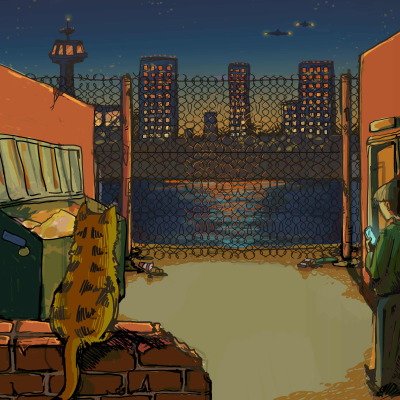
Contraptions
Podcast by Venkatesh Rao
Thinking out loud about the future of the world, as shaped by technological serendipity contraptions.venkateshrao.com
Aloita 7 vrk maksuton tilaus
Kokeilun jälkeen 7,99 € / kuukausi.Peru milloin tahansa.
Kaikki jaksot
29 jaksotHere’s a recording of a live video chat I did with my colleague Timber Schroff of the Summer of Protocols program. We’re gearing up to announce the 2025 program on Friday. It will be in the form of an overview essay, featuring a program philosophy riff by me, in our magazine Protocolized [https://substack.com/profile/309790256-protocolized]! Subscribe to that if interested. It features protocolized science fiction, essays (including the occasional editorial one by me) and program outtakes. In this video, Timber and I have a discursive chat about protocols, science fiction, Southeast Asia, efficiency/thoroughness/openness tradeoffs, mold vs. rust, and lots of other things Get full access to Contraptions at contraptions.venkateshrao.com/subscribe [https://contraptions.venkateshrao.com/subscribe?utm_medium=podcast&utm_campaign=CTA_4]
In this episode of Breaking Smart podcast, I want to explore what it means to say that Covid has accelerated everything. If so, it means we’ve done some time travel relative the old timeline. As the cryogenic lab tech said to Philip J. Fry on Futurama, when he landed in the year 2999, welcome to the world of tomorrow! 1/ Let’s set the stage a bit. We’re now in the early days of post-Covid for at least some people, in some parts of the world. We don’t yet know how costly the endemic management problem will be, in terms of treatment, vaccination, fatality prevention, and surveillance, but it feels like we have one foot out of the tunnel now. 2/ I don’t know about you, but I personally feel a bit like Fry in the pilot of Futurama. Right after he is greeted with “Welcome to the world of tomorrow!” he is assessed to determine what sort of “career chip” should be implanted in him, because in the bureaucratic future, everybody has a career determined for them. 3/ The joke is, he is assessed to be best fit to the job of “delivery boy,” the same job he hated in 1999, so he runs away from the career assessment officer, Leela. As it happens, by the end of the pilot, he ends up a delivery boy anyway, but with an illegal career chip, but is happy about it because he gets to work on a spaceship and has new friends. 4/ I hope to get my vaccine within the next few weeks, and the idea reminds me of the idea of Futurama career chip, including vaccine hesitancy. In many ways, this is not far wrong, what with all the talk of vaccine passports, green zones, and so on your vaccine status might shape your career. Unlike Fry, I don’t want to run from the career chip. I don’t have career chip hesitancy. I’m kinda looking forward to reinventing my life in ways that I didn’t expect to till 2031. 5/ Even the idea of a very bureaucratic future is not wrong. Given the amount of fiscal stimulus, the effects of new geopolitics with China, and vaccine nationalism, the role of states everywhere has become radically stronger. Like it or not, the world of tomorrow has governments everywhere getting more into your business, not less. Not least because governments effectively own a lot of assets through the loans they have provided for bailouts and stimulus. 6/ So the vaccine can be considered philosophically like a career chip for a new life in a future we’ve time traveled to, and are still getting used to. One of the signs for me has been that my Twitter feed, which is my main sense-making media feed these days, feels mis-tuned, and I’m re-tuning it. It feels like wearing glasses with the wrong prescription. Everything is a little blurry and distorted. 7/ Okay, so we’re in the future, and like Fry and other time travelers, one of our first questions should be, what year is it? Obviously, no provable answer is possible to this question, since we can’t actually run a believable no-Covid simulation. The new timeline might not even be comparable at all to the old one, because qualitatively different sets of things are happening or not happening. Maybe we’ve gone sideways rather than leaped forwards. Some parts of the world have definitely gone backwards. 8/ I do think the idea of an acceleration is well-posed though, and that we do overall have a forward acceleration rather than a sideways or backwards leap. I’m just going to propose 2031 as a strawman answer to what year it is, with the caveat that you shouldn’t anchor on it. The point of pretending we’ve time traveled 10 years in 1 year is to break old habits of thought and reorient. So how do we do that? 9/ One way to think of this is as a weighted average of trends by acceleration. So for example, if vaccines jumped ahead 20 years, but other kinds of medicine stayed the same, and public health for pandemics is 50% of all healthcare by cost, then you could say the average leap ahead is 10 years. 10/ But this is kinda silly, like applying a uniform rate of inflation even though your consumption basket may be very different from the consumer price index. In thinking about inflation, you should probably think about inflation in the specific range of goods you consume. So by analogy, in thinking about acceleration, you should think about the specific range of trends you’re riding, or not. A personalized basket of accelerations. 11/ For example, let’s say work-from-home would have progressed at a particular rate, such that we are now where we would have been in 2040 otherwise, which I think is true. What does that mean? Well for me, it doesn’t mean much, since I’ve been working from home since 2009. The big difference for me is actually being unable to work from Starbucks, and whatever acceleration is going to hit cafe culture. 12/ You can measure the importance of a particular acceleration in several ways. Like for WFH, you could talk about commute miles saved, C02 emissions from commute avoided, webcam sales, GDP of commercial vs. home office furniture, traffic at business district vs. entertainment district restaurants, etc. All these would be good macro measures of acceleration. 13/ At a personal level, you could simply think in terms of well-being improvements, and more time created due to not having to commute. The personal acceleration in this case could be an earlier arrival of lifestyle elements that you only expected with retirement, if at all. 14/ Some things are tricky when you talk about accelerations. For example, with a slower rate of shift to WFM, real estate would have evolved in sync, so commercial real estate would have shrunk, while residential square footage would have increased. But this takes time. Time we didn’t spend. So what are the implications of that? 15/ I recall reading somewhere that housing stock takes 70 years to churn, so if we logged 20 years worth of trend time in 1 year, then we have a churn-demand shock worth 1/3 of the total housing stock. Or to put it another way, 1/3 of real estate, both commercial and residential, is now either under distress from underuse or overuse. 16/ By a similar logic, car fleets take about 10-20 years to churn through, depending on the country’s laws about old cars. Public transit projects probably take about the same on average. WFH changed a lot of demand patterns overnight, so now you have idle cars and empty trains, and people rethinking their car situations earlier. 17/ When you look at all these individual accelerations, one thing that you might notice is that we’re talking about something very different from the acceleration due to Moore’s Law, the sort of everything-is-faster megatrend that gave rise to philosophies like accelerationism. 18/ This isn’t that. To the extent that was true, it is still going on. To the extent that was a shaky hypothesis, it still is. What we’re talking about is a different kind of acceleration from a one-time drastic shift, caused by a pandemic shocking the system into a new equilibrium that looks like the future we used to extrapolate. 19/ Let’s talk a bit more about how weird it is that we’ve leaped forward rather than sideways or backwards. A different kind of shock could have easily shifted us sideways into a kind of future we weren’t thinking about, a parallel timeline. Or it could have thrown us back into a more primitive past. But this one uniquely seems to have kicked us forward. Yes we’ve shifted sideways a little bit, and backwards a little bit, but the vector sum of all the accelerations seems to have been a global fast-forwarding effect. 20/ I think this is for two reasons. One, pandemics aren’t black swans. They’re not unknown unknowns. Not only do we have recorded histories of several examples to learn from, we’ve specifically had experts predicting this kind since SARS in 2003, and have even made what are in hindsight fairly realistic movies about it. Global civilization has a lot of cultural memory of pandemics, and ways of responding without being knocked off its historical course. This would not have been true of say an asteroid hitting earth or a major nuclear war. 21/ Second, many of the trends that have accelerated, such as WFH and climate action, were dealing with inertia effects. The pandemic did the equivalent of knocking out some inertia, causing a sudden, jerky leap forward. Kinda like dumping some cargo off an overloaded truck might cause it to leap forward. 22/ I think the right unit of analysis for thinking about acceleration is categories that have necessary, flexible roles in the world, with relatively linear evolution paths, no clear substitutes, and a lot of baggage available to shed. For example, cars, homes and countries. All are entities with steady rates of evolution, and loads of baggage. 23/ For example, cars were already undergoing dual trends of electrification and computerization, and on pre-pandemic timelines automakers were planning to fully transition to EVs in a decade or so. That’s probably accelerated because I suspect people will buy cars sooner now. 24/ EVs should be cheaper in the long run than IC engine cars, but in the short run, cars are actually getting way more expensive due to more compute elements. For example, cheap bumpers are now expensive to replace after an accident because they hold cameras and radars. 25/ So even though we’re probably in the same future qualitatively — more computerization and electrification is still going to happen, we’ve probably accelerated by at least a few years. Some things though, have shifted sideways. The idea of cars as a cloud-like on-demand service might take a hit, and more people might want to own cars. We’ve learned the importance of controlling some of your own physical assets and environments. Those who relied purely on rideshare or transit probably faced more risk last year. 26/ You can do a similar analysis for other stable units of our world. Countries are interesting. I’d say they were weakening before Covid, but have been made stronger. Vaccine development, public health management, and supply chain geopolitics have all strengthened the role of country-sized units. 27/ When you talk of more diffuse trends, without clear units, things get murkier. Two such examples are climate change and extremist politics. 28/ I think for a lot of people, Covid was a sort of prequel to how climate action might unfold. It doesn’t matter whether you believe in it or not, just as it didn’t matter whether or not you believed in Covid or vaccines. Enough people believe that there will be drastic responses. And I think Covid gave people sitting on a lot of capital a reason to start putting it into climate response investments. One example is the rise in SPACs. I suspect that’s going to be a lot more sideways than an acceleration though. 29/ It’s hard to judge what’s happened to politics, but I think it’s fair to say that both far left and far right currents got to crucial tests of their coherence and capacity to govern far earlier than they otherwise would have. Ideas that were outside the Overton window, like UBI got an early test through things like stimulus checks. I suspect the culture war overall accelerated by about 4-5 years at least. We’re already at the point in the conflict that might have otherwise arrived around 2025. 30/ To get back to the personal question, and the idea of a personal basket of accelerations leading to a personal estimate of how far in the future you’ve jumped, I think it’s a useful exercise to think about that, and also think about the question of what kind of new career chip you should install in your head, suited to the future you’re in, based on how far into the future you’ve leaped. 31/ How much of a jump have you made? I think looking at your typical sources of information and sensing how out-of-tune they feel, like with Twitter in my case, is a good starting point. The more weird your old pre-Covid news feed feels, the farther into the future you’ve leaped. 32/ Then you can think about the specific persistent units in your life, and how they might change or should change. In my case, I’m already thinking of living situations and travel plans in ways that I didn’t expect to be until 2031. I moved to a bigger apartment last year, and will probably look for a bigger place in a smaller city in the next few years. My domestic travel is probably going to go sharply down but my international travel and living might go up. 33/ I think the world of work has changed too. There is now more fat in supply chains, more resilience and sustainability in both production and climate senses. There is more national structure to industries. The story of vaccine nationalism might repeat in sectors like semiconductors and other critical and strategic ones. As a consultant, I’m rethinking how I approach my work. 34/ On this front, I am trying out patterns of work that I didn’t expect to see for years, such as more collaboration with other indies and free agents. I think relatively shallow managerial cultures are on their way out, and a more depth-oriented culture is on the rise, where people are expected to understand narrower parts of the tech stack, geographies, and markets more deeply. It’s an overall shift to a more vertical-grained global industrial structure, at the sectoral and national level. Again, this is what I expected with software eating the world, but not for another decade. 35/ Overall, I find this frame of a net acceleration, personalized to my context, very useful. The thought experiment of living in 2031, and installing a new career chip in my head, is very useful, and I recommend you try it. So that’s it for this week, I’ll be back again next week with another essay for subscribers. Get full access to Contraptions at contraptions.venkateshrao.com/subscribe [https://contraptions.venkateshrao.com/subscribe?utm_medium=podcast&utm_campaign=CTA_4]
In today’s episode of the Breaking Smart podcast, I want to discuss a concept I call demiurgical businesses that I think goes beyond the 3 kinds you may be familiar with: lifestyle, customer-driven, and product-driven. 1/ In the discourse around tech, both on the tech side and the techlash side, you’ll often hear the term “real problems” which should make you wonder what “unreal” problems are. 2/ When the term is used, it’s usually used by socially conscious people, whether builders or critics, who use “real problems” as the notional antithesis of whatever is behind what they see as bad, misplaced entrepreneurial priorities. Today it is NFTs, ten years ago it was apps. 3/ The term “real problem” is misleading because even though people who use the term will offer some cliched examples like climate tech or world hunger, the point of the term is to point at the thing being criticized, not the thing being aspired to. 4/ But if you take real and unreal seriously, you actually get an actually interesting train of thought. Usually, the thing being criticized is an example of a thing that doesn’t seem to solve any problem, whether real or made up. 5/ If you ask, “what problem does it solve?” about the thing being criticized, you’ll find that the people building it can’t even supply a bad, disingenuous, or morally indefensible answer. 6/ For example, if I answer the question, “what real problem does space exploration solve?” with “it helps discover better cancer drugs through zero-gravity biochemistry experiments,” you know that’s b******t. It is obviously a rationalization. It’s both a bad answer and a disingenuous one. If you claim it is a real answer, you’re either stupid or lying. I discussed the real answer [https://breakingsmart.substack.com/p/mars-and-the-meaning-of-money] for that a couple of weeks ago. 7/ For a morally indefensible example, let’s say I build luxury yachts with built-in torture chambers. The answer to “what real problem does it solve” would be, “the problem dictators have of partying and torturing their enemies at the same time.” Now that’s a bad and morally indefensible answer, but it is actually a real answer that points to a real problem that a real person has, just not a very pleasant kind of person. I’d want such a yacht if I was an evil dictator. 8/ If you think about it, there is no such thing as an unreal problem. If it can be posed as a problem at all, it’s real. You just may not share the motives or values of the person who wants to solve it. 9/ Or to put it more simply, the idea of a “real problem” is actually an expression of identity. Evangelizing “real problems” is a way to do identity politics by indirect means. The problem you choose reveals who you are, what values you prioritize, and what identity you’re attached to. 10/ An easy way to see this is to notice that “real problems” are actually a generalization of “customer-driven.” A real problem points to a real person who already has that problem — namely a customer. Whether it is hungry children or evil dictators. 11/ It might be quite abstract — for example, the “customer” for climate tech is people who believe in climate change and also believe it’s good to ensure the survival of as many humans and animals as possible, and will vote for politicians who will make policies in favor of that. But it’s still a direct equation between being customer-driven and focusing on “real problems.” 12/ I’ll even go further and say that all identities are in fact customer identities. So identity politics is actually customer politics. The only reason to have a stable identity is if you want to acquire something through it, whether it is through participation in family, community, the market, or politics. So things like race and ideology are customer identities just like preferring vanilla over chocolate ice cream is a customer identity. You buy things through those identities, even if it isn’t with money. 13/ If you’re familiar with the idea from Peter Drucker that the purpose of a business is to create a customer [https://www.ribbonfarm.com/2009/06/15/marketing-innovation-and-the-creation-of-customers/], this equivalence between “real problems” and pre-existing identities should be a red-flag for you. It means you’re talking about a world where innovation gets reduced to exceptional customer service through incremental improvements. 14/ So let’s ask again, what is the actual logical opposite of a “real problem?” We’ve already seen that “unreal problem” goes nowhere, and that “real” is just indirectly about affirming an identity, possibly while criticizing other identities. 15/ Here is my proposal: the opposite of a “solution to a real problem” — real to anybody, whether you think they are good or evil — is a “reality transformer.” Instead of solving a problem within reality as currently defined, in relation to a particular identity-based point of view, you make something that creates a new reality, forcing people to create new identities in relation to it. 16/ Twitter is my favorite example of a reality transformation business, or what I call a demiurgical business. Nobody asked for it, and even 14 years later it is unclear what problem it solves, and for whom. It was built because it was possible to build, and it ended up transforming reality for everybody. Now people have “real problems” within the expanded Twitter reality, such as being able to edit tweets. 17/ I used to think of this point of view as simply being “product-driven” instead of “customer driven” — see the potential within a new technological capability and work to realize it in a way that creates a new kind of customer, ie. catalyzes new identities in the market. I wrote a popular article about this in 2014, called Product-Driven vs. Customer-Driven [https://www.ribbonfarm.com/2014/04/24/product-driven-versus-customer-driven/], but that article now feels incomplete to me. 18/ The thing is, though product-driven businesses are in general more powerful than customer-driven things, most product-driven businesses are also often degenerate customer-driven things in disguise, where the customer is the entrepreneur. So you could call it entrepreneur-driven. 19/ An entrepreneur-driven business solves the problem of affirming the hardened, often narcissistic identity of the entrepreneur as the only real customer. They may want to put a dent in the universe, but typically they don’t want to put even a scratch on themselves. They want to transform without being transformed. Everything else is a side-effect. 20/ The side-effect is usually what we call product-driven: it creates a customer rather than serving an existing market. But the most important customer, the entrepreneur, remains unchanged. 21/ In my experience, I’d say about 90% of entrepreneurs are customer-driven. They build boring businesses that solve an existing problem for an existing customer, and make themselves and some others rich. About 9% are entrepreneur-driven: they work to validate the identity of the entrepreneur, and might distort reality for everybody else except the entrepreneur, via a reality-distortion product. That leaves the last 1%. 22/ This last 1% is what I think of as the truly powerful things. They transform reality for everybody, including for the person making it, forcing everybody to forge new identities. They transcend the product-driven vs. customer-driven dichotomy. Twitter is an example of this kind of business. It may have under-performed as a business compared to entrepreneur-driven businesses like Apple, Amazon, and Facebook, but it transformed reality more powerfully. 23/ It feels wrong to call the creators of such products mere entrepreneurs, since they are typically not about merely building a successful business or even validating their own identity. They act in the role of what the Greeks and gnostics called a demiurge [https://en.wikipedia.org/wiki/Demiurge]. Not quite a god, and not quite human. Agents of transformation who are themselves part of the transformation process and subject to it. 24/ Demiurgical businesses tend to be far more powerful than either customer-driven or product-driven businesses, even when they make less money. The limiting factor for customer driven businesses is existing identities in the market that can be served. The limiting factor for product-driven businesses is the existing identity of the entrepreneur that must be affirmed. But a demiurgical business essentially has no limits besides the laws of nature. 25/ Demiurgical businesses often convey the impression of having escaped the control of their creators. I once described Twitter as occupying a business space that is too big to nail [https://breakingsmart.substack.com/p/too-big-to-nail], a play on “too big to fail.” Just too large for any one business to fully occupy, and beyond the ability of any human CEO to govern. It’s not that the founders of Twitter were significantly less capable than those of Amazon, Apple, Facebook, or Google. It is that Twitter opened up a transformed reality that was too big to nail. 26/ In my experience, it’s definitely not the case that people who build demiurgical businesses are somehow more evolved or enlightened than regular entrepreneurs. Often, they are just as narcissistic and driven to validate their own fixed identity as product or customer-driven entrepreneurs. What happens is something like a natural accident. They stumble on an idea that is too powerful to be limited by their own identity. They have no choice in the matter. The thing they unleash transforms them, whether they want be transformed or not. 27/ You can reduce this whole idea to a 2x2: if the producer, or entrepreneur changes but the consumer doesn’t, you essentially have a lifestyle business. If neither changes, you have a commodity customer-driven business. If the consumer is transformed, but the producer is not, you have a product-driven business. If both are transformed, you have a demiurgical business. 28/ Personally, I like demiurgical businesses the most. They have the most powerful effects on our world, and are the only kind of business that can break humanity out of seemingly hopeless equilibriums, where everybody has locked-in identities, and is fixated on “real problems” instead of “transforming reality.” 29/ In fact, flipping things around, the things usually called “real problems” are in fact the most “unreal” of all. The fact that they exist as persistent, named conditions that seem to defy solution, and demand really virtuous behavior of humans suggests that there is a misframing going on somewhere. A problem that requires humans to be saints to drive solutions is not a problem. It is virtue blindness. 30/ Real problems are problems that real humans, not saintly ones, can solve. If existence is threatened by a huge problem that require us all to transform into saints to solve, then the problem is actually unreal since it involves imaginary, fictional human beings. The actual response to such problems is to transform reality in unpredictable ways through demiurgical businesses. That’s what can get the situations unstuck. Maybe in the transformed reality, the problem is actually possible for real humans to solve. Get full access to Contraptions at contraptions.venkateshrao.com/subscribe [https://contraptions.venkateshrao.com/subscribe?utm_medium=podcast&utm_campaign=CTA_4]
Space exploration has an unusual side effect: giving us a sense of the value of money on earth. 1/ The Perseverance rover, shown touching down on Mars in the photo below, cost about $2.2 billion to design and build, and about $243 million to launch on an Atlas rocket. 2/ Now that it is on the ground, if all goes well, and it is able to operate, it will cost another $300 million to operate for two years. So that’s at least $2.7 billion overall, or about 54,000 bitcoins. Hopefully more, if the mission gets extended. 3/ For those who don’t track this stuff, it is the fifth Mars rover, not counting the early Viking missions in the 70s which were not rovers. The previous ones were Sojourner, Spirit, Opportunity, and Curiosity. 4/ Perseverance is very much like Curiosity — about the size of an SUV, and powered by an MMRTG — Multi-Mission Radioisotope Thermoelectric Generator. By contrast, Sojourner in 1997 was about the size of a lawnmower, and the MERS were about the size of golfcarts. 5/ Probably the most charismatically interesting thing about Perseverance is that it is carrying a drone helicopter called the Ingenuity, which will be a genuinely fascinating thing if it works. An aircraft on another planet — one with 1/6 the gravity, and about 0.6% the atmospheric density. 6/ So how should you think about the value of the Perseverance mission? Some people who are space-exploration positive are still kinda defensive about such things and try to make up rationalizations like R&D benefits for problems here on earth. 7/ I think this is not even wrong. When someone asks why we spend money on Mars missions when there are starving children on earth, the answer is neither to make up specious theories of how space science can lead to life-saving medicines on earth, nor to walk away saying values are different, but to talk about how money works. 8/ Money is the largest-scale coordination mechanism we have for negotiating differences in values of things, and is what allows us to define what the word “we” means. Its design has to accommodate everything humans might disagree about. Money that cannot value space exploration or art cannot value medicines or food very well either. 9/ So I think the simplest mental model is as a civilizational art project. 2.7 billion is about 0.013% of the GDP of the United States. This is actually pretty cheap by civilizational artwork standards. 10/ For comparison, at the height of the Mughal empire, the Taj Mahal cost about a billion of today’s dollars, and a double digit percentage of the empire’s GDP at the time. Possibly as high as 20-25%. According to some historians, it contributed to the bankruptcy and decline of the empire. 11/ A good question about civilizational art projects is — who is the art project for. Whether you’re talking medieval monuments or Mars rovers, it is easy to figure out who the artwork is by, but it’s not always easy to figure out who it is for. 12/ Pre-modern civilizational art projects were generally monuments to the narcissism of emperors and religious leaders. To get people to accept the fiscal burden to undertake them, you had to make up myths and religions. 13/ There is some of that in modern space programs. We still quote Kennedy’s speech about getting to the moon. But even the most powerful modern cults of personality, whether you’re talking Kennedy or Trump or Xi Jinpeng, pale in comparison to the cults of old monarchies and religions. 14/ Presidents get to bask in the reflected glory of space programs a little bit, but ultimately, they ultimately get only a small slice of the attention. If you add up all the attention we give to astronauts and Nasa, and the people who work on missions, you still get a big deficit. You’re left asking, who exactly asked for this? 15/ It’s not even national pride really. Space programs in the 1950s were strongly linked to national industrial bases, but today, a modern space program, even the US space program, sources talent, materials and technologies from all over the world. 16/ For example, NASA has been promoting a PR video around the rover showing immigrants from all over the world who have worked on it. And on a material level, the rover uses many components from outside the US. For example, the motors used on the rover are made by a Swiss company called Maxon. 17/ So as an art project, I think it makes most sense to think of space programs as art projects by and for global economic systems. They represent an economic system as an emergent entity admiring itself in the mirror. In the case of NASA missions, it is the Western economy. In the case of China, it is the Chinese economy. 18/ What they do is help calibrate what an economic system is capable of, when stretched to its limits, and how it compares to competing systems. And this, I think, is not just valuable, it is functionally necessary. Any kind of economic system can only work if it constantly tests the limits of its ability to price things against competing systems. 19/ A functional economic system isn’t about judging human choices and preferences, but to price them. Everything from cancer drugs and aid to disaster zones to climate change and space programs to luxury yachts and obscene extravagances by rich celebrities. If humans are capable of it, a real economic system should be able to put a price on it. 20/ One of the reasons cryptocurrencies aren’t taken seriously yet is that the economic system they represent is restricted to a very small set of activities. It hasn’t been calibrated against a large enough scope of activities. The equivalent of space programs for the cryptoeconomy is games on the Ethereum blockchain like CryptoKitties or the recent innovations in NFTs (non-fungible tokens). It has a long way to go. 21/ Many people want to translate their political and ideological interests into economic terms. They want to somehow design an economic system that makes, for example, Mars missions so expensive we don’t do them, and saving lives so cheap, we never fail save them. But this is fundamentally wrong-headed. 22/ If you can’t come to terms with the diversity and variety of things humans want and value, and are willing to work for, you will want to design economic models to coerce them to act differently. This is a version of what statisticians call the bias-variance tradeoff, which I’m using as a metaphor here. The more you try to bias an economic system to do certain things, the more you’ll narrow the overall range of things it can do. 23/ If you think people suck, and try to make an economy that prevents them from sucking, you’ll either oppress people, or create an economy that sucks, or most likely, both. The only way we know to avoid that is to keep recalibrating the scope of the economy — the things it is capable of pricing, at the weirdest extremes, without unraveling entirely. 24/ In other words, if the economy does things you think are horrible, and refuses to do things you think are necessary, you don’t have a problem with the economy. You have a problem with people, and you’re not willing to cop to the desire for coercive control. 25/ Yes the economy has lots of distortions, but it had even worse distortions in the past when it was the plaything of emperors building monuments to their own grief. To make the economy better you have to remove distortions, not add them. And the only way we know to do that is to constantly calibrate by letting it do weird things so it can look at itself in the mirror. So that’s it for this free podcast edition. I’ll see you next week with another subscriber post. Get full access to Contraptions at contraptions.venkateshrao.com/subscribe [https://contraptions.venkateshrao.com/subscribe?utm_medium=podcast&utm_campaign=CTA_4]
In this first 2021 episode of the Breaking Smart podcast, I want to talk about something that’s been on my mind a lot lately that I call anti-network effects. 1/ As I am recording this, governments around the world are working out the logistics problems of distributing billions of vaccine doses. It feels like a symbol of the times we are entering into, times that I think will be defined by anti-network effects. 2/ Vaccinations and mask-wearing are examples of anti-network effects. I’ll define these as effects that can slow down, regulate, arrest, or reverse the operation of network effects, and which might themselves be network effects. 3/ For almost 50 years, since the invention of the PC, the world has been riding one network effect after the other, all of which ride on top of the infrastructural network effect of the internet. 4/ To review, a network effect is when the power of a system grows faster than its size. The original form was called the fax-machine effect. One person with a fax machine is useless. Two people is one connection, three people is 3 potential connections, 4 is 6, and in general n nodes is n(n-1)/2 unique connections. So the power of the network grows as the square of its size. 5/ Network effects in computing infrastructure are deeply connected to Moore’s Law. When computers get cheaper, network nodes get cheaper too, and more things can get attached to computers, and then to each other via the network. 6/ This leads to a double effect. Every 18-36 months, the density of transistors doubles. This makes the cheapest computers based on the cheapest chips much cheaper, and what’s more, this allows whole new classes of even cheaper computer to be invented ever decade or so. So one compounding effect rides another. That’s how we we went from mainframes to Raspberry Pis, and from an internet of 2 computers to an internet of billions. 7/ There’s in fact a third effect. If computers get more powerful at a steady geometric rate, and industrial mass production lag is minimal, then the rate at which the network can grow is itself a function of network size. You don’t have to add 1 node at a time, you can bulk-add n nodes. 8/ Everybody with a home computer already had an internet connection, so with a router, everybody can add a wifi connected device at the same time. With software it’s even easier: everybody with a phone can download an app at nearly the same time, creating near-instantaneous soft networks. 9/ We’ve been riding this triple-punch meta-network effect for nearly 50 years. You’ve got Moore’s law, the basic network effect of devices, and then the network-size-proportionate growth effect. And for people about my age and younger, our entire lives have been spent on this ride. To the point where it is second nature. 10/ This is actually pretty unnatural. Think about the classic brainteaser to teach exponential or geometric thinking. If a lily plant doubles in size every day and on the 30th day covers the whole pond, when did it cover half the pond? 11/ The answer is of course, the day before, on the 29th day, and to people like us, this barely even counts as a brainteaser. In fact, for kids today, I suspect the expected wrong answer, which is the 15th day, will feel unintuitive. They deal with fewer important things that work that way. 12/ There’s a lot more to say about network effects and various formulations like Metcalfe’s Law and Reed’s Law, but we’ve been doing that for my whole life, so enough said. I’ll just add one more point: network effects are pretty dumb. I mean even viruses and lily plants on ponds can embody them. 13/ This is in general not true of anti-network effects. While some anti-network effects are themselves driven by network effects, most work on other principles. So let’s take an inventory. 14/ The first kind of anti-network effect is self-limitation, when a network effect self-neutralizes. For example, once you have had Covid, reinfections are unlikely and you’re immune for a while. This is why you get an S-curve ending in a plateau, though a lot of people have to die along the way. 15/ Then there are anti-network effects that are themselves network effects, but distinct from the original one. Like the idea of wearing a mask spread pretty fast. Faster than the virus itself. The production of masks also spread via network effect. Some people saw others making masks and started imitating their behaviors. 16/ But many important things are not driven by network effects. Like when non-trivial habits have to be adopted. For example, disinfection and washing hands are behaviors that took a really long time to spread, and are still not universal more than a century after germ theory. 17/ Atul Gawande wrote a great essay called Sharing Slow Ideas [https://www.newyorker.com/magazine/2013/07/29/slow-ideas] in the New Yorker in 2013, that talked about innovations that are like this. That don’t spread like wildfire via network effects, but require pretty painful and slow diffusion via deliberate efforts. 18/ The reason slow-spreading non-network effects can sometimes still beat fast-spreading network effects is that they can be governed more intelligently. They are not as dumb as network effects. 19/ For example, it would be nice if we had a really dumb kind of network-effect vaccine that could be transmitted by a cough, via some sort of good virus that can fight the bad virus. Then the two network effects could race each other in a pretty dumb way. Explosion and counter-explosion. 20/ Unfortunately we don’t know how to make that kind of vaccine, that spreads via a network effect. Good things seem to spread slower than bad things in general. Brandolini’s b******t asymmetry principle [https://en.wikipedia.org/wiki/Brandolini%27s_law] is an example: it takes an order of magnitude more effort to refute b******t than it takes to produce it. 22/ The kind we do know how to make have to be slowly scaled in production, painfully distributed and administered by a small group of trained people. The only reason it has a chance is that we don’t have to be random. 23/ So that’s why governments are being deliberate and strategic in the order in which they vaccinate people. Of course you can be too careful. New York was criticized for expecting senior citizens to complete a complex form with 50 questions and multiple attachments to get vaccinated, and most efforts have now gone much simpler. Still, unlike the virus spread, it’s not dumb or near-random. 24/ You see the effect in computers too. In cyber-warfare, you don’t attempt to shut down the enemy’s capabilities by knocking out random computers in their network. You target key chokepoint routers or undersea cables. If you are an authoritarian government, you install firewall technology at the network edges. So those are anti-network effects that win by being topologically intelligent. 25/ There is a broader theme here: network effects are dumb, indiscriminate and very, very fast. They rely on abundance and target rich-environments. They think one step ahead in time, and one step around in space. But for those very reasons they are also very fragile. They can run out of raw material and starve. They can run into boundaries. They can even be slowed by simple ideas like six-feet separation. 26/ Anti-network effects sometimes incorporate network effects of their own, but are generally more deliberate, intelligent, and actively governed. They are designed with scarcity in mind and are not so easy to starve out. They have long horizons and think many steps ahead in time, and can be spatially intelligent across entire topologies. 27/ They need all these abilities because otherwise network effects have incredible advantages. Anti-network effects are like the tortoise that can eventually catch up with the hare. But because they lack exponentially increasing impact, they need other features to spread. 28/ Things can get worse though. There are network effects that also benefit from intelligence. Well-designed computer viruses are an example. They don’t spread indiscriminately. They can carry a payload of navigational intelligence in space and time and spread very intelligently. This is why countering clever computer viruses is so hard. 29/ There’s one more important class of anti-network effects we haven’t talked about, namely in information flows. After the January 6th storming of the Capitol, we saw how an anti-network effect operated with kinda stunning speed. 30/ The highlights, as you know, were that Donald Trump was suspended from major social media platforms, and Parler was suddenly cut off at the knees by major infrastructure providers. A good reminder that when the topology of a network effect is fragile — in this case the Trump influence network with Trump himself as a single point of failure — what takes years to build up can take minutes to shut down. 31/ That raises other issues I won’t get into, but here I just want to note that the anti-network effect here — simply cutting off a major source of disinformation and noise — was both easy and instantaneously effective. If you’re on Twitter, you’ve probably noticed how much drama has been cut out overnight. 32/ I want to round out this set of examples with another big important class of network effects and their anti-network effects: markets and regulation. Markets are generally based on network effects. Everything from price information to manufacturing capacity to early adoption tends to have a network effect in it. The economy grows via network effects, which is why critics compare it to cancers and viruses. 33/ Anti-network effects in the economy on the other hand, are slower and more deliberate. Anti-trust mechanisms are like taking out a major node once it reaches a certain scale. Monopolies are a special case. In network theory terms, they are a single node cut point, where for example, removing a producer entirely disconnects demand and supply. 34/ The broader theme I’m getting at here is that after 50 years of riding a big meta-network effect, we are entering an era of anti-network effects. Slower, more deliberate, more intelligent phenomena that achieve effects in very different ways. 35/ This is neither a good or bad thing. It is just part of how the world works. In biology, technology, and economics, there seem to be phases of dumb growth driven by network effects, and phases of intelligent regulation driven by anti-network effects. 36/ In a way this is how intelligence evolves. The human brain is like this too. There is a network effect in a baby’s brain during gestation as neurons get very densely interconnected in a pretty dumb way. Then as the baby learns after birth, the connections start getting cut and the ones left behind embody what we think of as intelligence. 37/ There’s going to be a temptation in the next few decades to come at this ideologically, like regulation and damping of network effects is always bad, and network effects are always good. After all that’s the religion the world has run on for 40 years. I’ve been raised on Reagonomics like most of you. But that’s all it is, a religion. 38/ The smart thing to do is to simply start learning the physics of anti-network effects. It is going to be hard for most of us below 50 since we have no memories of a world that was not being driven hard by network effects, but I think we can learn. At least it will be a fun new kind of thinking to get used to. A world in which the lily plant does NOT go from 50% to 100% on the 29th day. Get full access to Contraptions at contraptions.venkateshrao.com/subscribe [https://contraptions.venkateshrao.com/subscribe?utm_medium=podcast&utm_campaign=CTA_4]
Aloita 7 vrk maksuton tilaus
Kokeilun jälkeen 7,99 € / kuukausi.Peru milloin tahansa.
Podimon podcastit
Mainoksista vapaa
Maksuttomat podcastit



















